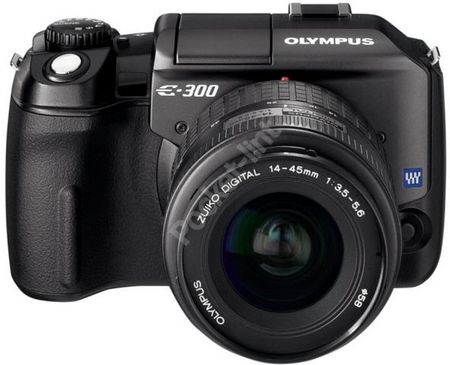The E-300 is the second, Four Thirds DSLR from Olympus and provides a value for money entry point into the world of the DSLR, competing well on price in the now very competitive DSLR market. It’s somewhat chunky design will look odd to SLR novices (its main target market, so a tad worrisome if you ask me) but comes about because of the unique porro-mirror (rather than pentamirror) viewfinder set up. The reflex mirror flips sideways directing the light-path to the right (as opposed to upwards) to the very slightly gloomy-to-use viewfinder.
Our quick take
The metering issue notwithstanding, image quality is very good, the kit lens is neat and lightweight and the camera packs in so much kit (+/-5 steps of exposure compensation is a very good example) that it opens up a rich tapestry of photography for those moving from compact digital cameras or migrating from film.
The design might put a few prospective buyers off their stride, but get down to a camera shop and test the camera for yourself, you may just change your mind.
Overall, then, this is a camera I can recommend and it comes at a great price too.

Olympus E-300 - 4.0 / 5
| FOR | AGAINST |
|---|---|
|
|
A neat Supersonic Wave filter activates whenever the camera is powered up, which uses very high frequency shaking to remove any dirt or dust from the sensor: it works very well, since no dust is evident in any of my images.
The camera handles well and although the camera looks quite stocky, all the controls fall nicely to the fingers, a deeply grooved right side grip makes the camera secure to hold and a single control dial, just behind the main mode dial is fast to use.
Talking of fast usage, the E-300 takes about 2 seconds to start up, so it’s not actually that fast in this department. Nevertheless, focus is fast and accurate and there’s virtually no shutter lag either, so it’s a responsive camera in use, even if a modest 2.5fps continuous shooting mode is a little disappointing.
Colour space assignment is possible with selectable sRGB and Adobe RGB spaces on hand, but the Adobe space is very saturated, looking quite rich and orangey in the high-contrast 1.8-inch "HyperCrystal LCD". On the other hand, this screen has a wide viewing angle of 160-degrees, which is important given the camera lacks other external displays (the "usual" LED indicators can still be found in the viewfinder though) making the set-up and menu review process quite fast.
The biggest problem by far I found on test is the metering, which seems to have a serious glitch where there’s a localised bright area in a scene. This makes the camera seriously underexpose the resulting picture. Recomposing the shot gets around the problem (as does exposure compensation or using the auto exposure lock) but it means it reduces spontaneity for fleeting shots. Two of the images in this review (a table in a restaurant shot against a bright window) show before and after compensating for the effect quite well. I metered from the nearby wall, just off centre to get the correct exposure.
The E-300 had a firmware upgrade (Version 1.2) announced which has been used for this review. Perhaps this is a missed opportunity as the metering issue might have been sorted out within this upgrade rather than a future one - it smacks of the bad habits of the PC peripheral world to release a model with an unnecessary flaw. As it is, the Version 1.2 upgrade enhances several aspects of the E-300 including: Shading Compensation, which minimises vignetting with the already very good kit lens, a 28-90mm (14-45mm actual) 35mm equivalent lens. Mirror Anti-Shock enables the mirror to be released before an image is taken avoiding "mirror shake" during shutter release for longer exposures. Release Priority ON/OFF gives enhanced shooting control where the AF has not locked on: you can choose whether the AF or shutter release has priority.
High-speed CompactFlash support for the camera’s chosen storage medium is now included, providing access to all the benefits of the latest high-speed CompactFlash memory cards, and finally there’s an improved battery check indicator for use with the HLD-3 Power Battery Holder.
The upgrade must be carried out using the supplied Olympus Camedia Master software (that also allows processing of the RAW files and basic image editing and browsing). The camera is upgraded through your Internet connection, making things problematic for those who lack an Internet connection or those who are still trundling along on slow dial up speeds.
To recap
It offers a very respectable spec in an ugly, but very usable body design
